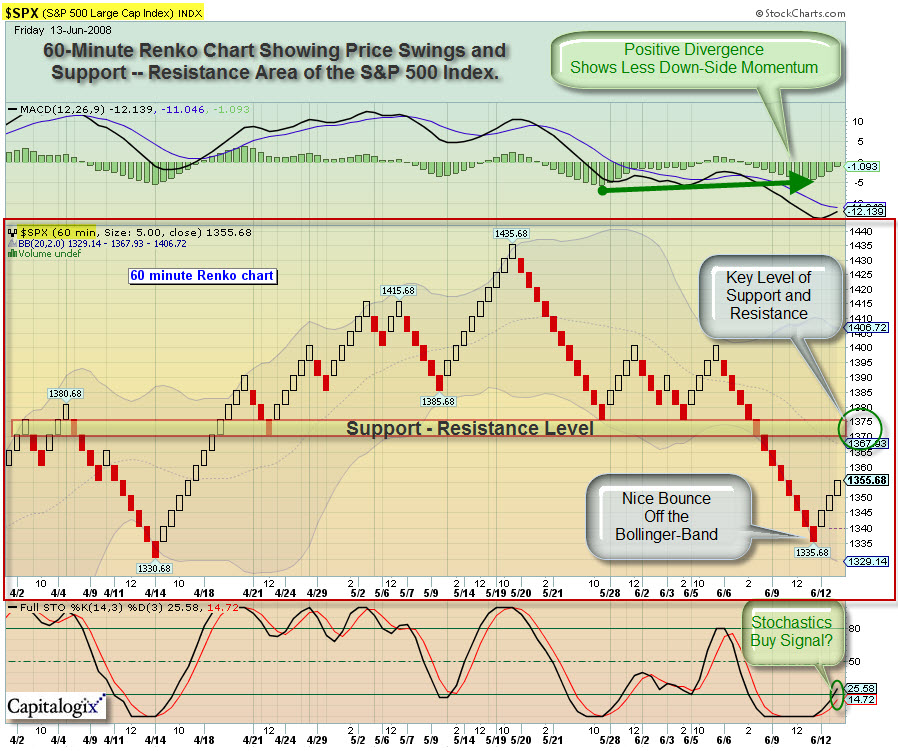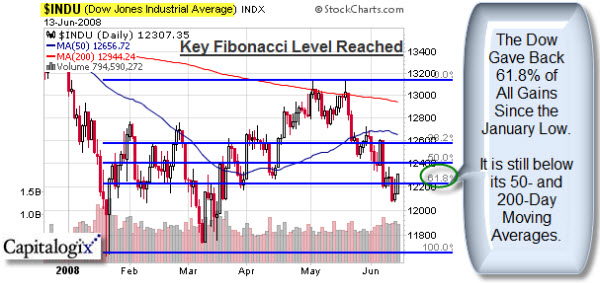
As noted, 6/18 is "Phi Day" for Fibonacci aficionados.
So, here is a link to a description of the sequence on Prechter's Elliott Wave website.
And here is a follow-up article.

As noted, 6/18 is "Phi Day" for Fibonacci aficionados.
So, here is a link to a description of the sequence on Prechter's Elliott Wave website.
And here is a follow-up article.
Einstein said: "We cannot solve our problems with the same thinking we used when we created them."
It got me thinking. Most trading charts are time-based (meaning that price change is measured against time). But maybe looking at price change in other ways would provide a different perspective.

Einstein said: "We cannot solve our problems with the same thinking we used when we created them."
It got me thinking. Most trading charts are time-based (meaning that price change is measured against time). But maybe looking at price change in other ways would provide a different perspective.

Wall Street is expecting another volatile week. In addition to our regular complement of oil price spikes, Dollar worries, inflation fears and economic reports on home building and wholesales prices … this week, the biggest news might be the quarterly earnings reports from Morgan Stanley (MS), Goldman Sachs (GS), and Lehman Brothers (LEH).
Currently, just 33% of stocks in the S&P 500 are above their 50-day moving averages. Much of this weakness has come from the Financial sector. Only 17% of Financials are above their 50-day moving averages. To see how ugly that sector has been, take a look at the charts of the Financial Sector SPDR (XLF) and the Banking Index ($BKX). Both are back at, or near, their lows.
But, next week also has Phi Day. What? Your friendly Fibonacci traders may note that June 18 is 6-18 (and everyone knows how important .618 is in trading). If not, then you haven't spent time at Prechter's site. Even if you don't believe it, enough traders watch the 61.8% retracement level, it is worth monitoring. For example, check out the current chart on the Dow.

Of course, not all US Equity Indices have fallen that far. In contrast, note the relative strength of the S&P MidCap Index.
Here are some of the things that caught my eye this week:
Wall Street is expecting another volatile week. In addition to our regular complement of oil price spikes, Dollar worries, inflation fears and economic reports on home building and wholesales prices … this week, the biggest news might be the quarterly earnings reports from Morgan Stanley (MS), Goldman Sachs (GS), and Lehman Brothers (LEH).
Currently, just 33% of stocks in the S&P 500 are above their 50-day moving averages. Much of this weakness has come from the Financial sector. Only 17% of Financials are above their 50-day moving averages. To see how ugly that sector has been, take a look at the charts of the Financial Sector SPDR (XLF) and the Banking Index ($BKX). Both are back at, or near, their lows.
But, next week also has Phi Day. What? Your friendly Fibonacci traders may note that June 18 is 6-18 (and everyone knows how important .618 is in trading). If not, then you haven't spent time at Prechter's site. Even if you don't believe it, enough traders watch the 61.8% retracement level, it is worth monitoring. For example, check out the current chart on the Dow.

Of course, not all US Equity Indices have fallen that far. In contrast, note the relative strength of the S&P MidCap Index.
Here are some of the things that caught my eye this week:
Is there really
an "Answer"? Doesn't each tick, each move, produce new questions?
It's
sometimes like a "Magic Eye" hidden picture. You are searching for the
vision and all you see is nonsensical chaos. Yet when seen from the right perspective, and with the right focus,
there is a higher order and the picture becomes clear.
Time plays a
role here. Timeframe plays a role here. But so does knowing when the signal to
noise ratio tells you not to pay attention. Sometimes noise is just noise.
I've
been thinking about how the market whispers when to play offense, when
to play defense, and when not to play at all. What gives us a clue
that something meaningful is happening? Is it:
As someone who's played this game for a long time, I'm not looking for magic bullets. But if I wasn't willing to look, it would be difficult find. So, model-building and testing will continue. I'll share more as the picture comes into focus.
Is there really
an "Answer"? Doesn't each tick, each move, produce new questions?
It's
sometimes like a "Magic Eye" hidden picture. You are searching for the
vision and all you see is nonsensical chaos. Yet when seen from the right perspective, and with the right focus,
there is a higher order and the picture becomes clear.
Time plays a
role here. Timeframe plays a role here. But so does knowing when the signal to
noise ratio tells you not to pay attention. Sometimes noise is just noise.
I've
been thinking about how the market whispers when to play offense, when
to play defense, and when not to play at all. What gives us a clue
that something meaningful is happening? Is it:
As someone who's played this game for a long time, I'm not looking for magic bullets. But if I wasn't willing to look, it would be difficult find. So, model-building and testing will continue. I'll share more as the picture comes into focus.
Great market action for bulls recently. If this has been a head-fake, it certainly was a convincing one.
The major US Equity Indices are all moving up to their 2008 highs – into their 200-day moving averages.
There has been a prolonged rally off the March lows, so you are going to hear lots of bearish predictors. It makes sense from the standpoint of price, time and logic.
Right?
For example:
But, you have to trade what the market brings you. And the market has digested bad news well recently. More importantly, we know that markets don’t have to trade logically. So keep your eyes open and respond intelligently.
Here are some of the things I read this week.
Hulbert sees several bullish indicators; here are two: Fosback’s Recession Buy Indicator and
Best Market-Timers Now Bullish.
Great market action for bulls recently. If this has been a head-fake, it certainly was a convincing one.
The major US Equity Indices are all moving up to their 2008 highs – into their 200-day moving averages.
There has been a prolonged rally off the March lows, so you are going to hear lots of bearish predictors. It makes sense from the standpoint of price, time and logic.
Right?
For example:
But, you have to trade what the market brings you. And the market has digested bad news well recently. More importantly, we know that markets don’t have to trade logically. So keep your eyes open and respond intelligently.
Here are some of the things I read this week.
Hulbert sees several bullish indicators; here are two: Fosback’s Recession Buy Indicator and
Best Market-Timers Now Bullish.

Fear, greed and hope comprise the Bermuda Triangle of trading. Many dreams were battered or lost because of them.
In trading, my goal is to make and keep money, consistently. It isn’t to be right, or clever, or even creative. Reducing human bias and error are benefits of using automated trading systems; and ultimately that helps us intelligently respond to the markets.
How does that apply to life?
Oh, a small question …
A friend of mine called me this week to share a thought. He said that he was trying to stop simply responding automatically to situations. Instead, he was going to consciously focus on his "intention" before responding.
Imagine how different the world would occur to you if you brought "intention" into focus instead of mindlessly surrendering to your first feelings and actions.

My first reaction often is to ask "what is the best next step?" Perhaps you do something similar? On many levels that is a resourceful question. Yet, what would happen if, instead, you brought your intention into focus and asked what role you could play to best support that intention?
Your role directly affects the options you perceive.
Let me know how that works for you.